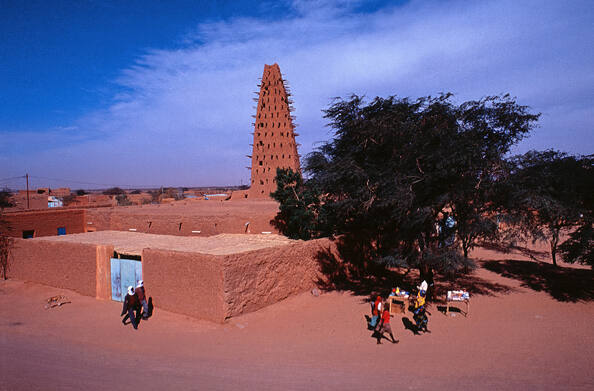Historic Centre of Agadez
Historic Centre of Agadez
Known as the gateway to the desert, Agadez, on the southern edge of the Sahara desert, developed in the 15th and 16th centuries when the Sultanate of Aïr was established and Touareg tribes were sedentarized in the city, respecting the boundaries of old encampments, which gave rise to a street pattern still in place today. The historic centre of the city, an important crossroads of the caravan trade, is divided into 11 quarters with irregular shapes. They contain numerous earthen dwellings and a well-preserved group of palatial and religious buildings including a 27m high minaret made entirely of mud brick, the highest such structure in the world. The site is marked by ancestral cultural, commercial and handicraft traditions still practiced today and presents exceptional and sophisticated examples of earthen architecture.
Description is available under license CC-BY-SA IGO 3.0
Centre historique d’Agadez
Considérée comme la « porte du désert », la cité d’Agadez, sur les franges sud-est du désert du Sahara, remonte aux 15e et 16e siècles. Le sultanat de l’Aïr s’y installe à cette époque ; il favorise le regroupement de tribus touarègues tout en respectant les anciens campements, ce qui conduit à une trame viaire originale et toujours respectée. Le centre historique, importante étape du commerce caravanier, est divisé en onze quartiers aux formes irrégulières. Ils abritent de nombreuses habitations en terre (banco) et un ensemble palatial et religieux bien conservé, avec notamment un minaret d’adobe de 27 mètres qui est le plus haut jamais construit en terre crue. Le site a développé jusqu’à aujourd’hui sa tradition culturelle, commerciale et artisanale et il offre des exemples particulièrement sophistiqués d’architecture en terre.
Description is available under license CC-BY-SA IGO 3.0
Centro histórico de la ciudad de Agadez
source: UNESCO/CPE
Description is available under license CC-BY-SA IGO 3.0
アガデス歴史地区
サハラ交易を担ったオアシス都市。アイール地方のアガデスは、この地方にスルタン制が敷かれた15~16世紀に成立し、現在も2万人が居住する歴史地区。トゥアレグ族によるサハラ砂漠交易の玄関口となり、文化交流が発展した。遊牧民のキャンプ地の構造を踏襲してそのまま街路網とした町では、多数の住宅のほか、日干し煉瓦造りの高いミナレットを含む宗教施設と、スルタンの宮殿との複合体が良好に保存されている。そこにはアイール地方特有の様式を反映した装飾とともに、きわめて洗練された日干し煉瓦建築の伝統が見られる。source: NFUAJ
Historisch centrum van Agadez
Agadez – de toegangspoort tot de woestijn – ligt aan de zuidelijke rand van de Sahara woestijn. De stad was een belangrijk kruispunt van de karavaanhandel en ontwikkelde zich in de 15e en 16e eeuw toen het Sultanaat Aïr werd opgericht en de Touareg stammen zich vestigden in de stad. Hierbij werden de grenzen van de oude kampementen gerespecteerd wat resulteerde in een stratenpatroon dat tegenwoordig nog steeds bestaat. Het historisch centrum is verdeeld in 11 onregelmatig gevormde wijken met goed bewaarde woningen van aarde en paleisachtige en religieuze gebouwen, waaronder een 27 meter hoge lemen minaret, de hoogste van een dergelijke structuur ter wereld.
Source: unesco.nl
